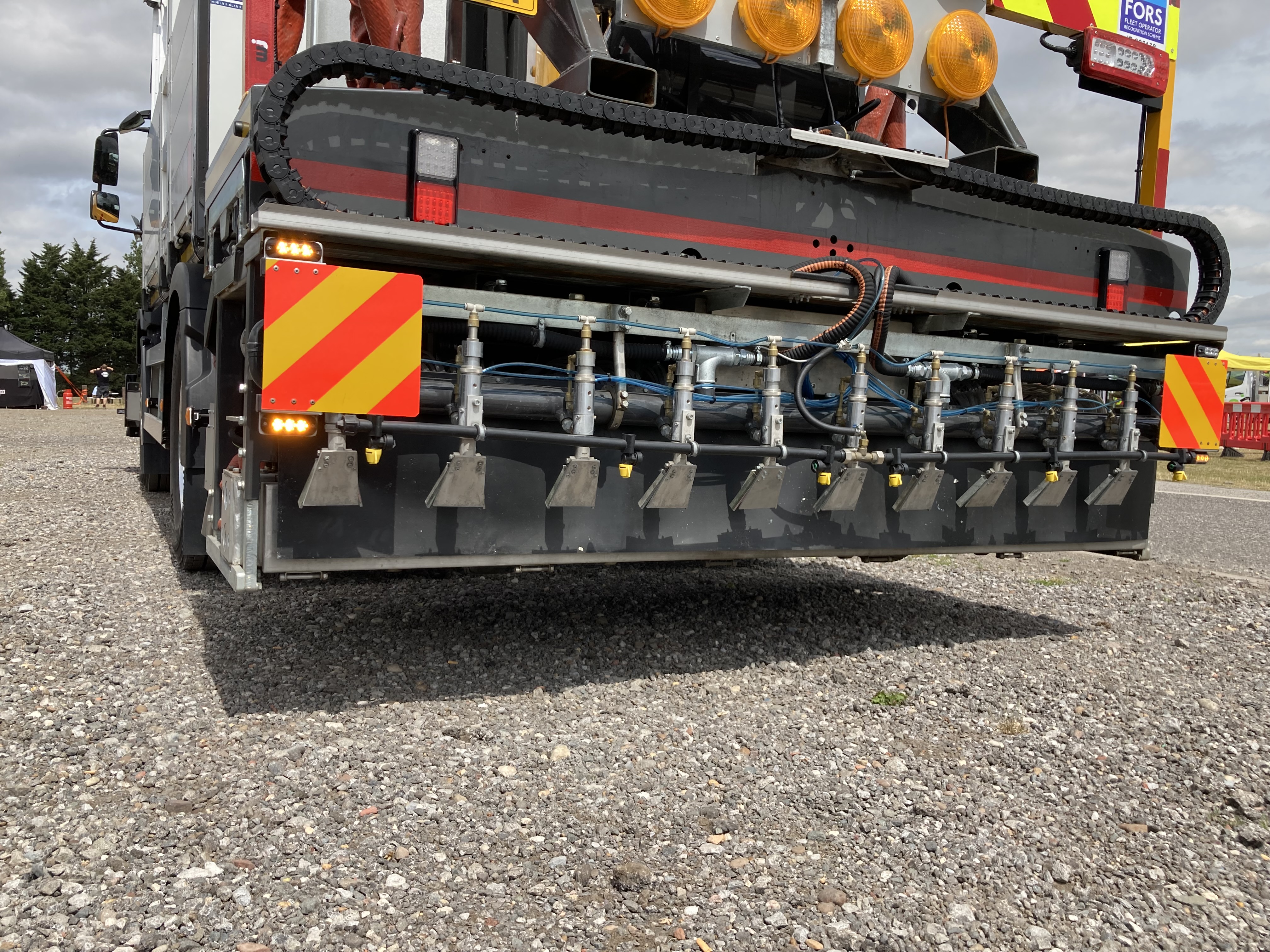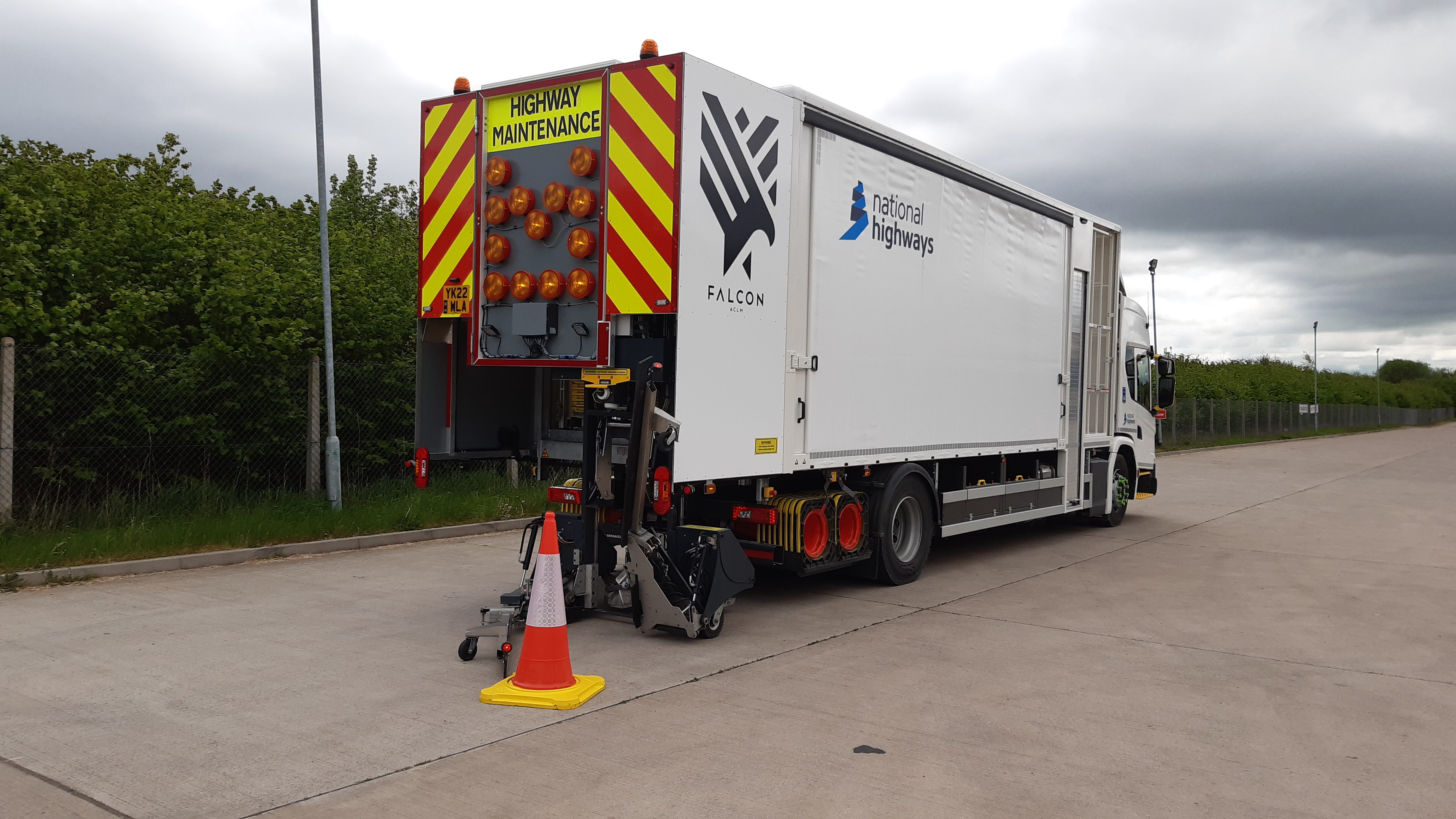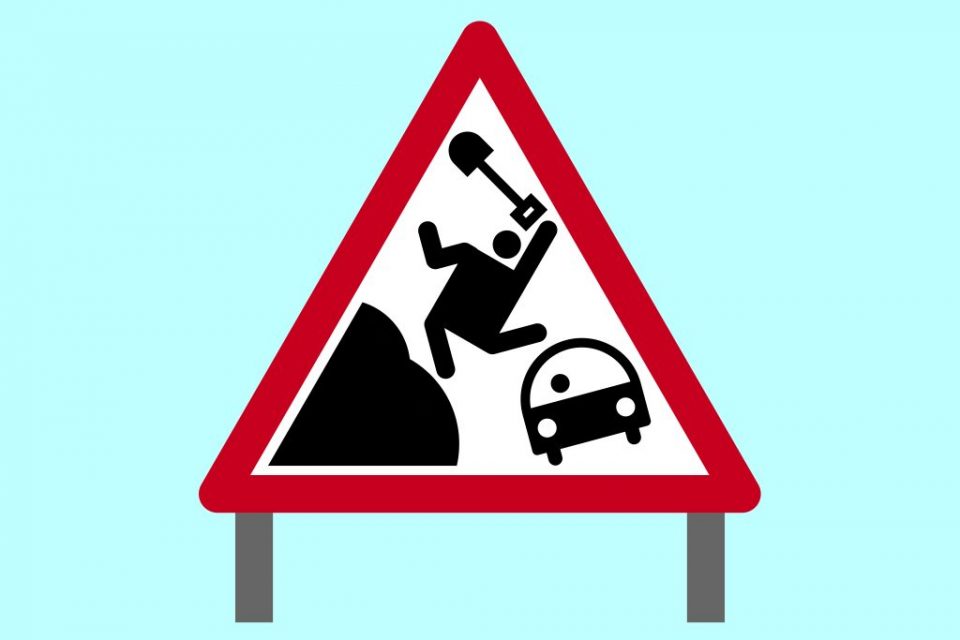Innovative solutions are keeping road workers safe as the push to maintain and improve the network continues.
Road maintenance operatives have a challenging job. They are often exposed to live traffic and often undertake labour-intensive tasks.
NCE recently received a response from National Highways to a Freedom of Information request about accidents and near misses affecting road workers.
It said that in 2021 there were 394 high potential near miss events and 43 lost time incidents – injuries resulting in the loss of productive time – among road maintenance and road building workers.
So far in 2022 there have been 115 high potential near misses and 10 lost time incidents.

Automated road markings printer removes the need for operatives to work in live traffic
The need to maintain and improve the road network is not only set to continue, it is expected to increase. National Highways chief executive Nick Harris has said that the focus of the third road investment strategy (RIS3), which will run from 2025 to 2030, is likely to shift away from major road projects to smaller improvement schemes.
“We largely have the road network we need and we’ve got to use the assets we’ve [already] got,” he told NCE’s Future of Roads conference in July. “It’s going to be about solutions that are not focused on building new roads or bypasses but about improving pinch points, improving safety. Smaller local solutions, junction improvements that help congestion, will improve air quality and reduce carbon.”
These smaller projects often require more complex and frequently changing traffic management arrangements. They carry an increased risk of accidents for operatives who set out cones and traffic management signs.
This is where technology comes in. Several innovations now in development are aimed at reducing the time workers need to be on the road and the number required on site.
National Highways’ Designated Funds have helped bring to market many useful technologies over the years. One example is the Falcon Automated Cone Laying Machine, developed by Highway Care and Switzerland-based technology firm Senn Engineering.
Cone laying can put workers at risk
While concrete barriers are now frequently used to separate major road building schemes from traffic, cones are more commonly used for minor schemes and placing them poses risks for road workers.
The cone laying machine aims to reduce incidents by minimising the time that traffic management operatives spend on the road network. It made its UK debut in July and Balfour Beatty has deployed it on the M25, following trials on the M4, among other routes.
Balfour Beatty Connect Plus Services traffic manager technical officer Dale Hicks explains: “The guys and girls on the network are put at risk each night with the travelling public coming at them. We take measures to protect them as much as possible – dual vehicle working, impact protection vehicles, working from footwells – but the risk is still there. The cone laying machine removes that risk considerably if not completely.”
With this innovation, you’re not on the road, you’ll be inside a vehicle, making it a safer option for all involved
Balfour Beatty Highways managing director Phil Clifton says the innovation “feels like another step change similar to when live lane crossing was banned”. In the past, operatives had to cross a live carriageway to set out a single off peak lane closure. Today, the number of crossings required is zero due to changes in guidance and standards.

Automated cone placing lorry removes risk to road workers
Clifton adds: “Similar to that, [the cone laying innovation] needed considerable investment and collaboration. Safety is an area where we should be collaborating, not competing.”
The cone laying machine has an easy to use keypad control panel and can be driven at slow speeds like an impact protection vehicle.
Operatives are less physically exhausted at the end of shifts compared to when they had to manually handle as many as 400 cones.
The approach brings other benefits, with long term scope for traffic management to be installed and removed more quickly. Over time the team hopes it could become the norm.
Road marking
Applying road markings can also be dangerous as operatives are exposed to traffic and are required to handle hot materials. Road marking company WJ Group has developed an innovative new machine which prints all types of road markings, removing the need for the manual element of the work. The technology is currently being further developed and trialled and WJ hopes to have it approved and in use by the end of this year.
WJ Group operations director Martin Webb explains that the task of applying road markings by hand is considered “one of the less safe aspects of the job, as it’s very labour intensive and you’re exposed to traffic, while also using hot material”. The new innovation is a machine called a ThermoPrint, a vehicle which prints small dots on the road to form the markings.
“With this innovation, you’re not on the road, you’ll be inside a vehicle, making it a safer option for all involved,” Webb says.
“We’ll have no one exposed to traffic, no risk of burns and no operatives carrying heavy buckets and laying material all day.”
A safety benefit for installation is less time on the carriageway which considerably reduces risk
The machine contains a library of road markings – for example “slow” or arrows – and markings are selected in the cab of the vehicle.
“We anticipate the machine will bring significant time savings when compared to applying the markings in its current form,” Webb adds. “You just need to turn up to site, select the markings you need to install and then it can all be done in one pass.”
Long term, the vision is for the machine to scan the road and print over the top of an existing worn out marking. Once the machine is positioned, operators will essentially press start and the machine will then print the markings.
According to Webb, there are some hurdles to get over with the material application: “because of the nature of the dots, it’s not 100% coverage” on the road and there are some tiny gaps between dots where asphalt is visible. In the UK, continuous lines are standard, but the standard states a minimum of 70% coverage is required. However, the team is looking at ways to ensure they exceed this.
“By using different materials at various temperatures, we can lower the viscosity so that it spreads further across the area to get that coverage,” Webb says. “We’re currently testing different materials to get the flow right.”
Faster CCTV installation
Meanwhile Clearway Technology has developed cable free, solar powered mobile CCTV towers to monitor traffic flows through traffic management. These can be installed faster and more safely for road maintenance work than more permanent structures. Installing traditional CCTV systems can take up to 12 weeks with operatives working on the side of the carriageway, installing cameras at height using mobile access platforms.
Clearway’s towers can be installed in as little as two shifts, with units assembled manually. In addition, because the towers are not connected to cables, there is no risk of cable strikes during installation. Removal is faster too.
There are also operational benefits. The system can identify stopped vehicles or queuing traffic and send alerts and images to operatives who can respond more quickly than if they were monitoring CCTV footage in a control room.
In addition, the system can count and classify vehicles and provide journey time information to road users, pushing messages to dot matrix road signs. It can also be used for site security and to check whether operatives are wearing personal protective equipment, for example. Using this technology removes the need to put operatives on the network to install other technology for these tasks.

These temporary CCTV cameras are quick to install and can perform a range of safety-related functions
“You’ve got a one stop shop for CCTV, stopped vehicle detection and site compound security,” explains Anthony Perry, training manager for Core Highways Group.
The towers have already been used by Forest Support Services, which is owned by Core, on the A38 Chudleigh Station flood alleviation scheme.
The project involves increasing the capacity of highway drainage on the side of the road and in the central reservation to increase run-off capacity. The run-off water is then attenuated and allowed to disperse into the nearby River Teign in a controlled manner.
The scheme was due for completion by mid-September and has been delivered with the aid of the new generation traffic management technology.
These mobile towers are also quicker to install than traditionally designed ones which would have to be placed on a concrete support.
Perry says: “A safety benefit for installation is less time on the carriageway which considerably reduces the risk. If you went for the traditional method and had a concrete block, you’d have to lift the concrete block in onto a base.
“We wouldn’t have been able to put those blocks on some of the locations where the cameras are because of the footprint of the block.”
Another element to be tested in future trials of the system focuses on incursions. The same technology will alert operatives on wearable devices if a vehicle crosses into the lane where they are working.
According to Clearway Technology highways general manager Simon Waterfall, the company has been “absolutely ecstatic with the success of the project”. Forest shared Clearway’s vision for a security industry product to provide “huge installation, operational, and wider scheme benefits”.
Crucially it has improved the detection speed of incidents to “literally instant notification”, Waterfall says. He adds that this has made the job safer for the operatives carrying out the work and for the public.
With the continued rollout of these technologies, there is hope that the number of incidents reported by road authorities will drop.
Like what you’ve read? To receive New Civil Engineer’s daily and weekly newsletters click here.


